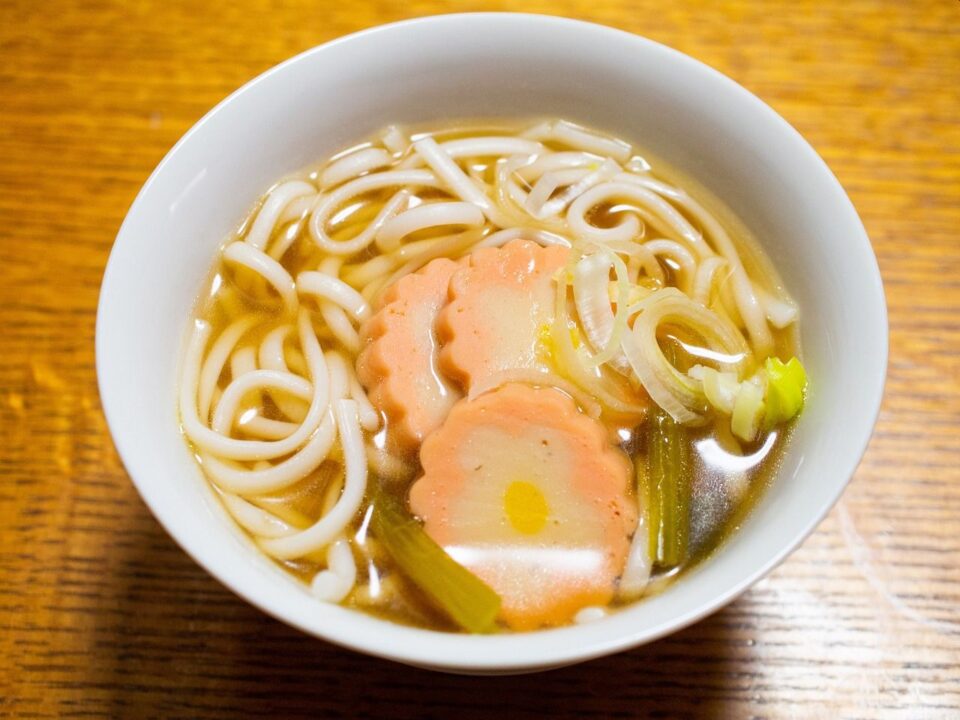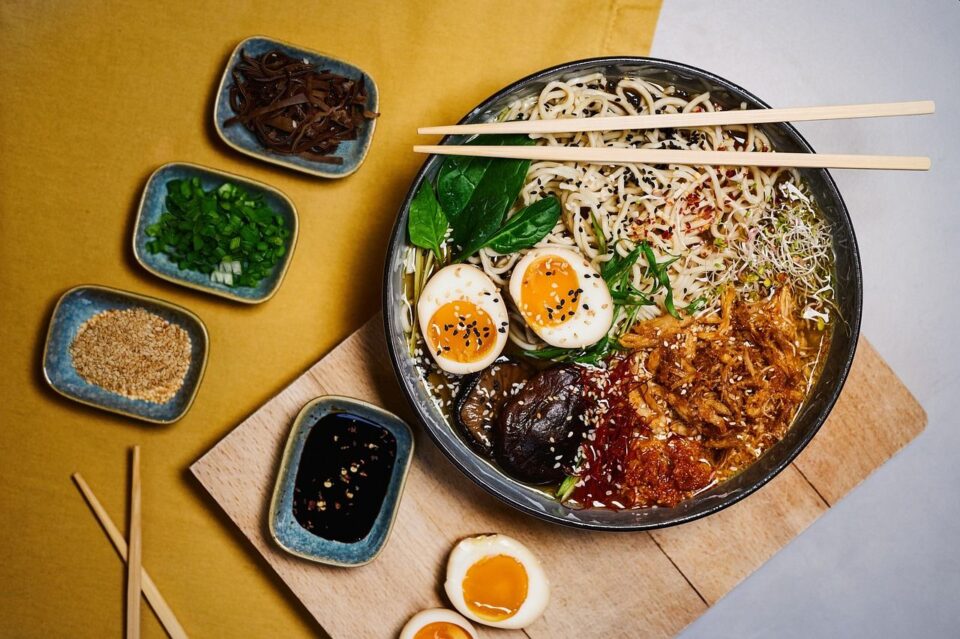Working on a recipe and need a good soba noodle substitute? Though a part of several delicious recipes of Japanese cuisine, there might be situations where you want to use an alternative.
While there are countless types of noodles available, a substitute should have suitable qualities to stand for the original. The slightly nutty flavor and somewhat grainy texture are the hallmarks of soba noodles, and a substitute should come somewhat close to these qualities.
Since soba noodles can be served either hot or cold, the consideration for substitutes can also depend on the specific recipes and your culinary goals.
But there’s more – diet preferences can play a role in your need for a substitute. So, we’ll discuss some relevant points there as well.
Generally, the best substitutes for soba noodles are udon noodles, whole wheat thin spaghetti, ramen noodles, Korean buckwheat noodles, zucchini noodles, and kelp noodles.
Of course, there are many factors that can govern this substitution, so let’s get into the details to see how it all works out.
Table of Contents
About Soba Noodles And Factors Important To Its Substitution
Soba noodles are a famous part of Japanese cuisine and are sometimes used as a representative dish for the country’s rich culinary tradition. Several recipes use these noodles and they can be served cold (often with a dipping sauce) or hot (usually in a soup or broth).
The word soba literally translates to buckwheat, which is what these noodles are made from. Buckwheat is naturally gluten-free and has that coarse texture that lends itself so well to these noodles. However, being gluten-free, the noodles made entirely from buckwheat don’t bond as well and can be very brittle.
To get around this issue, soba noodles usually contain about 20% of wheat flour, which helps keep the soba noodles in shape and well-bonded.
One famous variant of these noodles is the Okinawa Soba, which is popular in Japan’s Okinawa prefecture. The Okinawa soba is made entirely from wheat and doesn’t contain buckwheat. Because of this construction, it is very similar to, and can be easily replaced in recipes by udon and ramen noodles.
However, for the purpose of this article and our current discussion, we’ll limit ourselves to the conventional soba noodles, the ones made from buckwheat.
Sourcing soba noodles is usually not the problem. They’re fairly popular and can be found in Asian stores, online, or even big box stores. Although, to be fair, even though they are available in most places, they may not be available everywhere.

At The Heart Of Soba Noodle Substitution: Buckwheat
Considering their origins from buckwheat, soba noodles have a rather unique taste and texture profile. Buckwheat is not often used in making noodles and that makes substituting for soba noodles all the more difficult.
While there are several options that could match the general texture of soba noodles, matching the flavors is a whole different story. And in substitution, this is the part that’s often sacrificed. So, while most substitutions will do a good job with most characteristics of soba noodles, getting the same flavor isn’t always possible.
There is, however, another side to this story as well. In conventional Japanese cooking, the taste of the noodles is often important, similar to the flavor of the sauces and soups that they’re served with.
Though in other countries, the tastes are often adjusted to meet local expectations and preferences, which often comes at the cost of the subtle flavors of the noodles themselves. For purists, such a change is usually not acceptable, but then, neither is substitution!
With that, let’s get to our options for soba noodle substitutes.
Top Soba Noodle Substitute Options To Consider
1. Some Gluten-Free Products
As the world gives more attention to food and diet preferences and requirements, several new products and brands have emerged.
And this is where you often find the best alternatives to soba noodles, made from buckwheat. As we know, buckwheat is gluten-free and so it can show up in gluten-free products like noodles, spaghetti, and others.
Very likely, you’ll be looking at a product like gluten-free buckwheat noodles, buckwheat spaghetti pasta, buckwheat capellini pasta, and so on.
Some sellers even offer buckwheat ramen noodles, which is pretty much the same as soba noodles.
Finding buckwheat gluten-free products can be a bit more difficult than conventional gluten-free products. Many gluten-free products prefer other flours like sorghum flour, rice flour, etc. Yet, they’re not entirely rare, and with any luck, you should be able to find them.
2. Korean Buckwheat Noodles (Naengmyeon)
Korean buckwheat noodles (Naengmyeon) can be a bit more difficult to find as compared to soba noodles, but they serve pretty much the same purpose and can be used as an alternative to soba noodles for almost all recipes.
However, there are significant differences between soba noodles and naengmyeon. While buckwheat is the primary ingredient in Korean buckwheat noodles, they typically also include potato starch or sweet potato starch, along with arrowroot starch.
This gives Naengmyeon a relatively chewier texture when compared to Soba noodles.
3. Whole Wheat Spaghetti (Pasta)

Spaghetti pasta comes from an entirely different cuisine and region of the world, but this Italian dish can be a suitable replacement for soba noodles in several recipes.
While buckwheat spaghetti would be very useful for substitution, it’s relatively rarer than whole wheat spaghetti. The whole wheat spaghetti gives a good approximation of the buckwheat texture and the nutty flavor, though the overall flavor certainly is a slight departure from conventional soba noodles.
Yet, as substitutes go, the pasta can pass off as a decent alternative to the noodles.
One trick some people use is to add a little bit of baking soda to the water when boiling spaghetti. This change can make it more similar to noodles. Generally, this method is used to make conventional wheat flour spaghetti more like ramen noodles. However, it may also work for whole wheat spaghetti and its similarity to soba noodles.
Other, similar pasta can also work as a decent substitute. This includes capellini pasta, angel hair pasta, and similar pasta where you can draw parallels with noodle shape.
Ingredient usage of these pastas dictates how well they can work as a substitute. Those made from buckwheat would be excellent, while those made from whole wheat flour can pass off as decent substitutes. Those made from sorghum flour, conventional wheat flour, or rice flour could work as basic substitutes, but at that point, most defining properties of soba noodles would be absent.
As such, buckwheat spaghetti or whole wheat spaghetti (or similar pasta) can work as a decent soba noodle substitute. However, pasta made from other ingredients, while workable, is not a great choice.
4. Udon Noodles

Udon noodles are one of the most popular types of noodles and see a wide application in recipes across several Asian cuisines. And while they will work as a substitute for soba noodles, they also bring several changes to the general taste and texture.
Made from wheat flour, udon noodles are relatively thicker, creamier, and smoother when compared to soba noodles. Much like soba noodles, they can be served hot and cold and work with similar recipes.
5. Ramen Noodles

Ramen noodles are perhaps amongst the most famous types of noodles, with fame in popular culture and general availability. These curly white noodles are relatively quick to prepare and have a remarkable texture. The primary ingredient for these noodles is wheat flour and they work absolute wonders when served hot in soups or similar dishes.
On the other hand, while cold ramen recipes exist, they don’t fit into the same style as soba noodles. As such, while ramen noodles work as a soba noodle substitute in hot recipes, they don’t fare well in cold recipes.
6. Zucchini Noodles

While they have been used for a long time in recipes, zucchini noodles are seeing increased popularity, thanks to interest by specific diet preferences, especially vegans. They’re also useful for those who want to avoid carbohydrates that come with flour like wheat, rice, or even buckwheat.
Zucchini noodles are the best-known and preferred variety here, though other similar types may also be employed, including butternut squash, beet, etc.
These noodles work very well in hot and cold recipes. Though the texture, flavor, and ingredients of zucchini noodles are very different from soba noodles, they can work rather well as a substitute for soba noodles, especially for those with specific diet preferences.
7. Kelp Noodles
Kelp noodles, as the name implies, are derived from a specific variety of kelp. While they don’t match soba noodles in taste, texture, or even color, they are fairly versatile and can work with most recipes.
Therefore, using kelp noodles is not an ideal substitution. It is, however, useful for some diet preferences, and are especially liked for being keto-friendly.
Choosing Your Soba Noodle Substitute For Deliciousness
Now that we’ve covered soba noodle substitute ideas in detail, along with notes for diet preferences and taste expectations, it should be possible to pick a substitute best suited for your needs. The amazing and famous soba noodles are versatile, can work with several recipes, and can be served hot or cold.
Their unique styling and ingredients make them somewhat difficult to substitute, but the ideas here should help you get a suitable choice.

